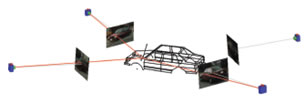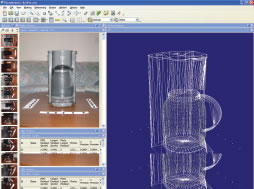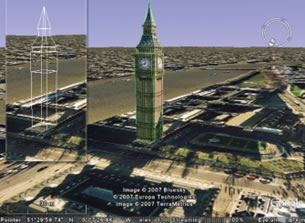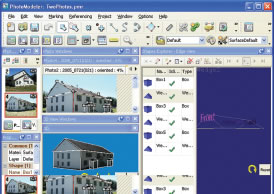PhotoModeler 6
Get precise digital models from photographs as well as artifacts - even Google Earth uses it.
Latest News
November 2, 2007
By Mike Hudspeth
 Figure 1: Import overlapping bitmap images into PhotoModeler 6 that show the object from as many sides as possible, and you can reverse engineer anything. Figure 1: Import overlapping bitmap images into PhotoModeler 6 that show the object from as many sides as possible, and you can reverse engineer anything. |
Do you wish you had hidden under your desk or do you accept the challenge willingly?
A quick review of the dozen photos shows all different angles, illustrating each feature on the device in at least three pictures. If you’ve got a scanner and PhotoModeler 6 from Eos Systems Inc., based in Vancouver, BC, you’re in business. No challenge at all — you simply fire it up, sip your coffee and, before you know it, you have a model.
How’s It Do That?
PhotoModeler 6 is all about photogrammetry — the science of pulling accurate measurements from photographs. All you need to do is make sure that the features you want to show are seen in more than one image. Which views you use is less important than making sure you show everything you need to build. If the images are digital to begin with, skip scanning and simply import them into the program. At that point, you mark key features in the images that are visible in other images so PhotoModeler 6 understands they refer to the same feature in each view.
The program uses a “bundle adjustment” algorithm that records all these points and interprets them in 3D space. This lets it compute where the camera must have been when the pictures were shot (see Figure 1).
PhotoModeler 6 can actually end up being more accurate than the photograph if set up correctly. If enough geometry is identified, results improve. Resolution — the number of points you specify — is the key (see Figure 2).
And if you want to reverse engineer an object in your possession, you can get amazing results by adding targets to the object. These are targets (usually small high-contrast circles) that you apply to your model before you take the photos. The program knows their size so it has a scale reference. Even if you don’t use the targets, PhotoModeler 6 will still produce a model, but the overall size will be up in the air until you specify how big things are. All you need do is establish the distance between two specific points.
 Figure 2: You point out to PhotoModeler 6 various points that appear in multiple photos (the more the better) and it will interpret the object accuratelyin 3D space, regardless of size. |
|
PhotoModeler 6 will build your model using forms it’s familiar with (see Figure 3) and give you actual NURBS surfaces that you can export to other programs using standard translators such as DXF, 3D Studio 3ds files, VRML, IGES, even STL (to name a few). Of course, you can always tweak the model at any time to fix something that might be slightly off.
Numerous Applications
 Figure 4: You don’t always have to model everything. PhotoModeler 6 can wrap photographic images on the model’s surfaces and make it look like the real deal.Google Earth uses it. Figure 4: You don’t always have to model everything. PhotoModeler 6 can wrap photographic images on the model’s surfaces and make it look like the real deal.Google Earth uses it. |
As I worked with PhotoModeler 6 I tried to think of how it could be used. It’s not hard to imagine. Archaeologists would be a natural fit for this technology. They could document an entire dig. They find an historic artifact, photograph it, process it with PhotoModeler 6, and anyone interested gets the chance to see it. You can model the overall geometry and then wrap a photographic image onto it. When you’re done you’ve got a virtual artifact anyone can look at on the Internet at their leisure. Engineers can model things to design for and around. Plant designers or architects can model entire building sites (see Figure 4) with uncanny results.
PhotoModeler 6 can even remove perspective distortion and correct for physical anomalies in the camera’s lens. (In fact, you can calibrate for your specific camera in about an hour.) Police crime-scene investigaton teams can use PhotoModeler 6 to reconstruct a crime scene assisting defense lawyers and prosecutors to win their cases using such comprehensive reconstructions. I have it on the hush-hush that the government might be able to use it to analyze enemy technology. Or maybe even explore some pretty “far out” stuff at a certain numbered area out there in the Nevada desert.
An Exciting Technology
In all sincerity, I know that some folks are saying, “I can do the same thing with a pair of calipers or even a ruler.” But think about it for a minute. This is a noncontact method of achieving high-quality models that can be as automatic as you are comfortable with, and it’s only $995 (the upgrade for version 5 costs $395).
Returning to our original premise of the museum piece, what if you need additional measurements? You might not have access to the piece anymore. But photos? You’ve got all you need. This is exciting technology that can make what you do all the easier to accomplish. Check it out.
More Information:
PhotoModeler 6
Eos Systems Inc.
Vancouver, BC
photomodeler.com
Mike Hudspeth is a senior designer for a global medical company and has been using a wide range of CAD products for more than 20 years. He, his wife, two daughters, and their cats live outside of St. Louis, MO. Send him an e-mail about this article to DE-Editorsmailto:[email protected].
Subscribe to our FREE magazine, FREE email newsletters or both!
Latest News







